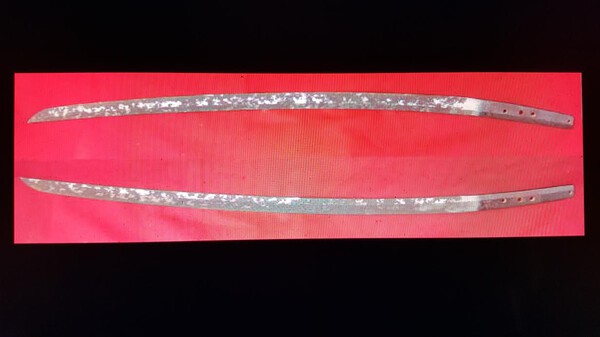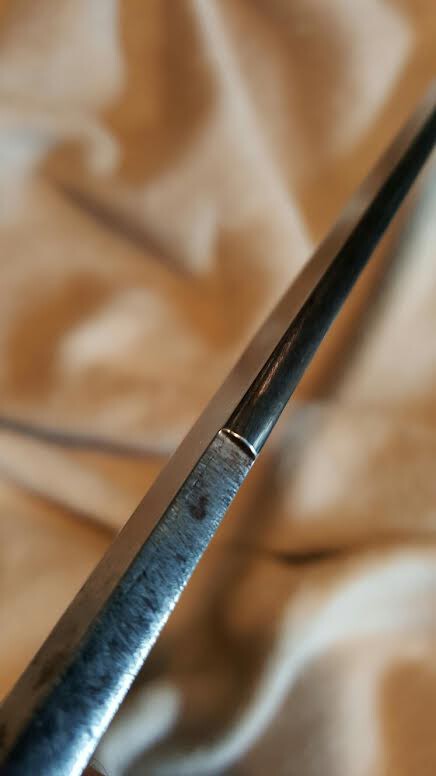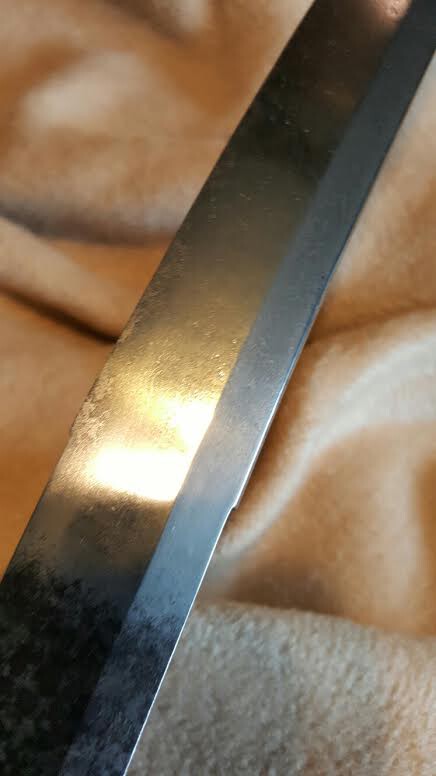
jct3602
Members-
Posts
171 -
Joined
-
Last visited
Content Type
Profiles
Forums
Events
Store
Downloads
Gallery
Everything posted by jct3602
-
Just had some repair done on the tsuka and saya of what I thought was a boy's sword. The restorer said he thinks it might have originally been a kodachi which had some very nice furniture added to it to make it a boy's sword. My question is what is the smallest dimensions that anyone has seen for a kodachi or the largest for a young boy's sword? The dimensions of the piece in question are as follows: blade length - 44.1 cm motohaba - 2.0 cm sakihaba - 1.45 cm kissaki - 1.7 cm sori - 1.1 cm, over a 5.1 cm span almost precisely in the middle of the blade - within .2 cm of same distance to the kissaki and to the motohaba. Even for these tiny dimensions, the blade is very thin and lite. Am enclosing picture -
-
Hi James - It feels like Muromachi to me also. The tachimei and very shallow marumune initially threw me off, but perhaps it was from a rustic area. As an old Japanese gentleman at the Burlingame token-kai observed, it seems that the smith was illiterate and possibly copying from something a priest gave him. Given that the more well-known areas had people for hire to chisel signatures, another indication of perhaps non-mainstream origin. Bunmei would fit with Stephen Strauch's opinion of an early Sukesada. thanks, john
-
Hi Jim - Asked Michael Bell the swordmaker about the muneware and he said it was a minor problem that a good polisher could make virtually invisible. My 2 mentors have both strongly urged me to get it polished; Michael and Stephen Strauch in Portland (Steven has unearthed 4 swords in the US that went Juyo after polishes, and now has a ko-Motoshige that after a top polish will probably be even better than the 1st 4). Stephen gave me the name of a polisher/s that was recommended to him by Dr. Tanobe, and presently trying to make connections. If unsucessful, will submit it to shinsa in Burlingame in the fall. As an aside, Michael recommended getting it polished before my other polish-worthy blade, which papered as NTHK kanteisho with a den Kunimune atribution at the last Burlingame shinsa (Jimmy Hayashi earlier said it was late Kamakura or early Nanbokucho). Personally, am very curious as to what the polisher would attempt to present; the hada is very strong, but so are the nie effects. Stephen's opinion is 1500's Bizen or a very early Sukesada; he thinks he sees utsuri where all i can see are areas of profuse nie along the shinogi. Jimmy says Mino, Michael says Soshu; all 3 of them know way more than i do, though my opinion is Mino. The partial mei also inclines me to your 1500's opinion; if the reign year is indeed 14th, that makes a 1500's date very likely (only 3 that long or longer previous to 1500 - shohei, oyei, and bunmei, but 4 between 1500 and 1600 - yeisho, tembun, tensho, and keicho - brit spellings, lol). Thanks for all of the fine input john
-
hi SAS - Picture of the temper in the shinogi-ji. (not a great picture, but same sort of activity dropping from the mune entire length both sides) john
-
-
Hi again - More thumbnails - the parallel lines of undulating higher carbon metal run unbroken the entire length of the blade to the kissaki. For SAS - the blade has a very shallow marumune that is also hardened; tears of hardening dropping from the mune into the shinogi-ji throughout. In at least one area, they also have a visible nioi habuchi. john
-
Thanks for all the replies - Been away following my favorite college football team. No acid was used at any point to remove rust - just uchiko and occasionally a slurry of hazuya paste. After that, used a slurry from a 6000 grit finishing stone; originally with rice paper and later with soft cotton; has taken me over 10 years, little by little. The remaining pits are about 5 - 10% of the original pitting; monitored throughout by Michael Bell, who has more than a passing acquaintance with polishing, since he studied with Nakajima in San Francisco and now makes swords. I stopped for about 4 years before I found the 6000 grit stone, since the surface was showing some etching. In any event, Michael has followed it since I got it as a mass of rust 10 years ago and in his professional opinion I have done no harm and a lot of good (no one had any idea of all the activity that was going to show up; I was advised by a dealer to throw it away when I first bought it). It will be heading off to Japan for polish shortly. Will post some more pictures - both sides of the mei, the original internet pictures of the blade, and the hada pattern when I stopped for fear of etching. john
-
I am willing to learn from my own ignorance, so I will try: 4 - kamakura, 3 - nanbukucho, 2 - early Shinto, 1 - early 1500s muromachi. john
-
More poor pictures - 1st from outside of blade 2nd from inside. Showing either kinsuji/inazuma or very thick sunagshi lines. john
-
thanks Paul - I think it is Mino also; people who have seen it live have a variety of other opinions. Michael Bell, who makes Japanese swords and is a neighbor of mine in Oregon, thinks Soshu. My personal mentor (who has unearthed 4 swords that went Juyo and has a 5th awaiting polish (a very fine ko-motoshige)) thinks Bizen, either a Soden smith or an early Sukesada. Michael feels that the upthrust portions of the hamon on the inside of the blade are not really togari. Both of my friends have seen the blade often over a 10 year period, The blade is tachi mei, but the top 2 characters of both the signature mei and the date mei have been filed over; there are about 5 characters visible on each side, and a portion of a 6th on the signature side where the nakago ends. The nie is actually much nicer looking under normal conditions, but I wanted to get a picture and it was expanded. The motohaba is 2.65cm and the sakihaba is 1.75cm, koshisorii. Since it is marumune along with being tachi mei, I think it was a late koto (1500s) attempted copy of some earlier blade. the visible characters of the date mei are 14th year (the 10 character is a little questionable), 2nd month, a day. The signature is kuni - (tsugu or ji) - sa - emon -nojo - unreadable partial character. the kuni from its position I believe is the 3rd character of a province designation (parallel to the 10 character on the opposite side). If the date mei is actually 14th year, that would severely limit the possible periods, since there are only 2 reigns before 1469 that lasted that long, but 5 between then and 1600. Hopefully I can get some better pictures before I send it off - there are some relatively long (5+cm) inazuma/kinsuji that look interesting. Thank you for your thoughts; wish I could get clearer pictures to present. john -
-
A suriage 56.7cm blade with a lot of nie effects; although buried under the nie, the habuchi is consistent thickness nioi. Will be heading off for polishing shortly, but interested if anyone has any thoughts on its origin. Also, there are some nie formations near the shinogi in one of the pictures that I wonder how to describe them - dense jinie or something else? The overlying nie almost buries the lines of the hamon near the nakago on both sides; however, the blade is machi-okuri so that area was not the original base. Dense sunagashi also obscures the basic hamon through much of the blade; the reason for the one out of place picture was to try to show the hamon. Thank you, john
-
Just a random question for anyone interested. When you get a polish through on an old blade, how much, if any, does its position and nature tell you about the construction style of the blade? It would seem to me that kobuse would polish through near the shinogi, where the skin metal is thinest, and the spot would be relatively dull, since the core metal is not folded as many times and is softer and lower grade. Original san-mai would have its polish throughs closer to the ha (at the bottom of the side metal where it thins), and the spot would be edge steel, so the hada would not be as glaringly different as in the kobuse example (if positioned right next to the already visible edge steel, the hada would seem very natural) I still am trying to visualize where the spots would occur on 5 piece and more complex constructions. Have to think about where polishes remove metal most frequently and how that the various metals exposed would contrast. Any input would be appreciated john
-
Thanks Brian - I will try to crop my pictures to the maximum i can. The detail that the new cell phones have on pictures is better than most cameras were 4 years ago; mine has a 16 megapixel camera (still can not handle the autofocus very well). john
-
Hi Jean - The reason I asked was I wanted to post a new topic with a picture (showing interesting nie activity), but when I did the preview of the post, the image that I wanted to send had been reduced from 3.8MB to 87KB, more than a 40-1 compression rate. The resulting image could not be magnified without pixelating and in any event was relatively useless, so I was stuck. (the image showed a stream of nie running immediately below and parallel to the shinogi in the monouchi; I was asking whether it would be considered just an area of thick ji-nie, or yubashiri/ji-utsuri etc.) Thanks much, john
-
Hi Jean - Thanks for the info.! john
-
Excellent photos. How did you manage to transfer that excellent huge image at the start of this kantei quiz? I have had a great deal of difficulty posting any images on this site that have not suffered greatly through compression at various points in the transfer stream. John
-
Ken, my cleanup has been with uchiko and elbow grease; that is why it has taken so long. All along the way i have asked many knowledgeable individuals to monitor what i have been doing. When i felt the blade was beginning to etch a little i stopped entirely for about 4 years, and did not restart until i had an alternative to the uchiko. What i am using now is a 6000 grit Japanese artificial stone (which i believe is a finer grit than uchiko, and certainly more consistent) and making a slurry with it, once again using fingertip pressure only. This was a piece that went unwanted on EBAY, except by me. Bought it to practice clean-up and until well along in the process, very few other individuals recognized any quality in it. If i were wealthy i could take every piece of junk i see and send it to a polisher, but i am not and would not. Will try to get better resolution, but the compressions that my picture went through started at 6.0mb and ended at 86kb. This site does not appear to allow better than 200kb in any case. Blade is certainly koshizori; maximum sori is 1.5cm at 34cm from the tip (total length of blade is 56.8cm). Figuring in the nakago, maximum sori is 2.8 cm at 43cm from the tip. Suriage was about 5.5cm, given the position of what remains of the mei. Motohaba 2.60cm and sakihaba 1.75cm; kissaki 2.80cm. Very slender from many polishes; thickest point just below the beginning of the suriage filing. Thought it had no yokote when i got it, and only later could barely feel a slight rise. Very old black rust and some gray. In any event, was asking about fully tempered mune; would appreciate any wisdom on that topic. john twineham
-
Have been working on an old suriage wakizashi (partial tachi mei) which i got as a complete mass of rust years ago to practice clean-up. After 400-700 hours of work (maybe more, lol) over the last 10 years, it has shaped up very well. (attatching one of the original pictures from the internet purchase from Japan) One of the more puzzling aspects it has presented me is that it has a very shallow maru mune which appears to be fully tempered, with tempered extrusions falling off the mune into the shinogi ji continuosly along both sides of the blade. Is this just a form of muneyaki combined with tobiyaki in the shinogi ji, hitatsura, or something else? Is it common to have a fully tempered mune? For years i thought i was just imagining the tempering, but the mune is giving me the same problems in rust and pit reduction that the tempered areas of the ha have (and the ji has not). The tempered areas in the shinogi ji coming off the mune have a habuchi border if that matters. Any ideas or information would be appreciated. john twineham
-
As a follow-up on Arnold's post, the following question - I have read that retempering sometimes increases the curvature of a blade. It would seem that although water lines on retempering could be covered up by the filing of the new portion of the tang following suriage, radical changes in curvature could not. Assuming the original smith wanted a smooth curve, if you see an old tachi where the curvature is substantially more extreme than that of the continuation through the nakago, might this indicate retempering at some point? John T.
-
Nakahara states on Pg 61 "to define the correct curvature of a tachi, a line should be drawn fron the very butt of the tang to the tip of the sword... Currently, swords are measured by using a line from the end of the back surface of the sword (mune-machi) ro its tip...This kind of measurement is only used for sword licensing." I realize that tip to mune-machi is the standard commonly used, but when comparing measurements of sori to those of tachi in old texts (such as the Showa Dai-Meito Zufu), which measuring standard did they use? Does anyone have an answer that they feel confident in? john twineham
-
The effect a polisher could have after work to remove chips probably also matters. For instance if Darcy's Soshu blade had a wide enough ha to withstand the removal of significant chips, that 5:2 ratio could be substantially altered. Blades falling in the middle of the range of proportions might shift to a relatively wider shinogiji after polish unless the polisher reestablishes the shinogi in accordance with the school. which leads to the possibility - A poor diagnosis of school by an inexpert polisher might lead to no replacement or misplacement of the shinogi and have an effect on perception of width. Just thoughts since width of the shinogi is an important kantei point. I do believe that approaching the Golden Mean in art is of great importance (for Darcy)
-
When a blade has a new full polish, does the burnishing of the shinogi-ji and the mune obscure muneyaki and tempered spots in the shinogi-ji, either in part or totally?
-
Ron, thank you for the picture. What significance, if any. to the shallowness of the marumune on my wak? Trying to clear things up to the point where i can submit it to shinsa at a Burlingame Token-kai, hopefully next year. Looks to be Mino in Soshu style.
-
I feel ignorant, but what standard is used to decide that a shinogiji is narrow or wide? Is it purely sibjective, or is there a general rule dealing with the ratio between the width of the shinogji and the width between the shinogi and the cutting edge? thanks, john T
-
Thanks for all the replies - Here are 2 pictures of the mune to give an idea how shallow it is - The wakizashi is about 2.80 cm at the machi. John T.



















